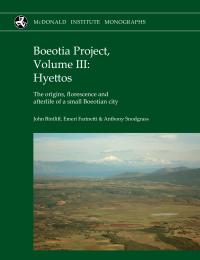
Our full catalogue is presented here by publication date. Our publications are distributed by Pen & Sword Books/Casemate Academic. Direct links to Pen & Sword Books are included in the catalogue where the book is still in print. We also sell some of our publications as e-books.
Volumes published under the McDonald Conversations Series (online open access only) have links to the University of Cambridge repository Apollo, where they may be freely accessed.
A small number of back catalogue volumes, where marked, are also available for sale as e-books.
Publications
Boeotia Project Volume III | Hunter gatherers |Falerii Novi | Keros VII | Cattle, community and place | Must Farm Volume 1 | Must Farm Volume 2 | Interamna Lirenas | Ancient Egyptian gold | Inspired geoarchaeologies | Temple people | Gardening time | Fierce lions, angry mice and fat-tailed sheep | Making cities |
2025
Boeotia Project, Volume III: Hyettos The origins, florescence and afterlife of a small Boeotian city
by: John Bintliff, Emeri Farinetti & Anthony Snodgrass
Hardback | £ tbc | $ tbc | ISBN | 600 figs | 60 tables | 2025 | Coming soon!

The case of Hyettos involves a polity so thinly documented, for its era, that its reconstruction resembles more that needed for a prehistoric site (which indeed it initially was, from the Neolithic onwards). But for the contribution of the geophysical survey, it would have impossible to put together a narrative of what was a highly unexpected course of development.
Instead of the familiar pattern of a millennium of steady growth and decline during Classical antiquity, often only interrupted by violent external intervention, we find that the very compact town-plan of about 12 ha belongs to one of the late stages in the history of the ancient site, after c. 300 bc. Before that, the ceramic material of Archaic and Classical Greek times had been spread, more thinly but over a much wider area of about 20 ha. This chimes with the evidence of an acropolis fortified in the polygonal style characteristic of the years around 500 bc, and with the extraordinary discovery of an inscription at Olympia, showing that Hyettos had in the same general era been at war with the greatest city of Central Greece, Thebes. This story is thus one of an early climax in size and importance, reached nearly two centuries before that of every known city-state in surrounding Boeotia, with a subsequent peaceful decline into obscurity, in which its continued independence for a time offered the only relief.
John Bintliff was Professor of Classical and Mediterranean Archaeology at Universiteit Leiden NL, and is now Honorary Professor in the Department of Archaeology at the University of Edinburgh.
Anthony Snodgrass is Laurence Professor Emeritus of Classical Archaeology of the University of Cambridge.
Hunter-gatherers in the landscape Surveys and excavations in the eastern Vale of Pickering, 1976-2000
by: Paul J. Lane, Tim Schadla-Hall & Barry Taylor
Hardback | £52.00 / $ tbc | ISBN 978-1-913344-20-7 | xxiv + 407 pp. | 218 figs | 214 tables | 2025 | Buy now
eBook | ISBN 978-1-913344-21-4 | xxiv + 407 pp. | 218 figs | 214 tables | Download now for free
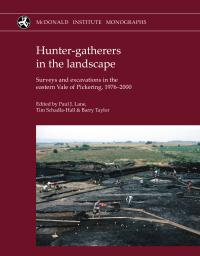
This monograph presents the results of over twenty-five years of archaeological and palaeoenvironmental research on the Late Glacial (Late Upper Palaeolithic) and Early Holocene (Mesolithic) landscape of the palaeo-Lake Flixton in the eastern Vale of Pickering, North Yorkshire. Initially conceived as a rescue project focused on Seamer Carr, an area of land lying a few kilometres northeast of the well-known Early Mesolithic site of Star Carr, the project ultimately developed into a much wider study of the early prehistoric occupation of the former lake and its environs. By the time the project concluded it had successfully mapped much of the shoreline of the former lake and developed a detailed account of both the human and environmental histories of this landscape.
While some elements of this research have been published previously, this volume represents the definitive report on the results of the project, and the research strategies employed to investigate an entire landscape buried beneath peat deposits, and with little visible evidence for human activity on the modern ground surface. The data produced by the project, brought together in this volume, provides an unparalleled analysis of the changing nature of Late Upper Palaeolithic and Mesolithic settlement in lowland northern England and helps place the extensively excavated site of Star Carr in its wider landscape context.
The financial support provided over the course of over four decades of fieldwork and post-excavation activities by Historic England (and its previous iterations as English Heritage and the Ancient Monuments section of the Department of the Environment), North Yorkshire County Council, the Leverhulme Trust and a host of additional sponsors of the Vale of Pickering Research Trust (VPRT) is gratefully acknowledged. As is the generosity, logistical support, contributions and patience of the numerous landowners, VPRT trustees and fieldwork supervisors and volunteers over the years, without which this work would have been impossible.
Paul Lane is the inaugural Jennifer Ward Oppenheimer Professor of the Deep History and Archaeology of Africa at the University of Cambridge, and the Mandela Magdalene Memorial Fellow.
Tim Schadla-Hall† was Reader in Public Archaeology at the Institute of Archaeology, University College London, and formerly the Director of Leicestershire County Museum Service.
Barry Taylor is a Senior Lecturer in Archaeology at the University of Chester.
Falerii Novi The Ground-Penetrating Radar survey of the Roman town
by: Martin Millett, Alessandro Launaro, Lieven Verdonck and Frank Vermeulen with contribution by Konogan Beaufay
Hardback | £50.00 / $ tbc | ISBN 978-1-913344-24-5 | xiii + 162 pp. | 66 figs | 10 tables | 2025 | Buy now
eBook | ISBN 978-1-913344-25-2 | xiii + 162 pp. | 66 figs | 10 tables | Download now for free
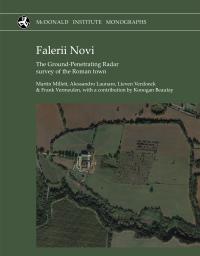
The Roman town of Falerii Novi was founded after Rome defeated the Faliscans in 241 bc, and features widely in modern discussions of Roman expansion in Italy, with its town walls and defences often illustrated in accounts of architecture. Its site is now largely farmland, with the only buildings within the Roman walls being a Medieval church and associated structures, now used as a farm. The site attracted attention of 19th-century antiquarians and was explored in limited excavations during the later 20th century, but its history and development remain only partially understood. In the late 1990s it was the subject of one of the first large-scale geophysical surveys completed in Italy using magnetometry. The publication of that work in 2000 formed the basis for an historical and archaeological interpretation that has subsequently been widely debated. The present volume results from a second innovative large-scale survey which deployed Ground- Penetrating Radar. This book presents the spectacular results of that work combined with evidence from the earlier magnetometry and integrated with information from excavation and past finds. The resulting account provides a full and new discussion of the town and its topographical and historical development, placed in the broader setting of Roman Italy. It includes a new interpretation of the early history of the town, discussions of the evidence of the major buildings as well as a series of accounts of spatial patterning within the city. As well as providing the first comprehensive synthesis of this important Roman town, the book shows how evidence from geophysical surveys can form the basis for new approaches to the understanding of Roman urbanism.
2024
Monumentality, Diversity and Fragmentation in Early Cycladic Sculpture: the finds from the Special Deposit North at Kavos on Keros
by: Colin Renfrew, Peggy Sotirakopoulou & Michael Boyd
Hardback | £55.00 / $ tbc | ISBN 978-1-913344-22-1 | xiii + 285 pp. | 171 figs | 24 tables | 2024 | Buy now
eBook | ISBN 978-1-913344-23-8 | xiii + 285 pp. | 171 figs | 24 tables | Download now for free
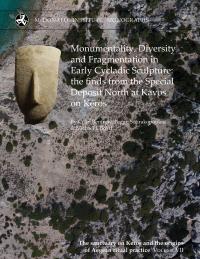
The Early Bronze Age sanctuary at Kavos on Keros was discovered in 1963 in the aftermath of a catastrophic episode of looting. This volume publishes the important series of 314 fragmented Early Cycladic marble sculptures recovered between 1963 and 1987, after the initial looting. The assemblage, with significant new forms including fragments of musicians and a number of monumental pieces originally more than 1m in height, adds significantly to the understanding of Early Cycladic sculpture. It supplements and extends the information gained from the excavations of 2006 - 2008 in the Special Deposit South, published in Volume III of the present series, together presenting the largest overview available of Early Cycladic sculpture from authorised excavations, and therefore of undoubted authenticity. Alongside detailed descriptions, photographs and drawings, the authors discuss the themes of production, scale, typological diversity, painted decoration, fragmentation, special types, the roles of the sculptures, and the nature of the Keros sanctuary.
Cattle, community and place The archaeology of the Cambridge Biomedical Campus
edited by: Jonathan Tabour with Tom Phillips
Hardback | £45.00 / $ tbc | ISBN 978-1-913344-18-4 | xx + 376 pp. | 176 figs | 111 tables | 2024 | Buy now
eBook | ISBN 978-2-913344-19-1 | xx + 376 pp. | 176 figs | 111 tables | Download now for free
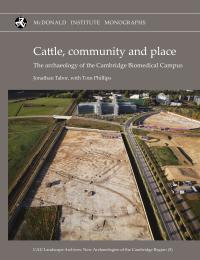
Detailing the results of excavations undertaken by the Cambridge Archaeological Unit at the Cambridge Biomedical Campus between 2007 and 2016, this volume builds upon the work of previous large-scale projects within an area that now represents one of the most intensively investigated archaeological landscapes in Britain. Also included is a chapter contributed by Oxford Archaeology East concerning their excavations within the Biomedical Campus, which has enabled full publication of the site’s archaeology in a single volume.
The excavations exposed three major sites: a Middle Bronze Age enclosure complex, a Late Iron Age–Early Roman farmstead with associated ring-ditch cemetery, and a first- to fourth-century AD Roman farmstead. The archaeological evidence and analyses of the sites’ substantial artefact assemblages and economic data are presented alongside detailed consideration of the palaeoenvironment and Bayesian modelling of radiocarbon dates relating to the Middle Bronze Age enclosure sequence. Preliminary results from aDNA analysis of burials from the site’s small Late Roman inhumation cemetery and the nearby Late Iron Age/Early Roman cemetery at the Hutchison Site – previously excavated and published by the Cambridge Archaeological Unit – are also included. Together, the results provide new and important insight into the region’s prehistoric and Late Iron Age–Roman settlement, their respective economies and the communities that inhabited them.
Must Farm pile-dwelling settlement: Volume 1. Landscape, architecture and occupation
edited by: Mark Knight, Rachel Ballantyne, Matthew Brudenell, Anwen Cooper, David Gibson & Iona Robinson Zeki
Hardback | £45.00 / US $ | ISBN 978-1-913344-14-6 | xx + 328 pp. | 191 figs | 30 tables | 2024 | Buy now
eBook | ISBN 978-1-913344-15-3 | xx + 328 pp. | 191 figs | 30 tables | Download now for free
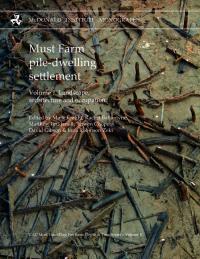
The Late Bronze Age pile-dwelling settlement at Must Farm is one of the most important and best-preserved prehistoric sites to have been systematically excavated in Europe. The settlement comprised a curving palisade enclosing five stilt-raised houses erected above a freshwater river channel at the edge of one most Britain’s most intensively studied and internationally renowned Bronze Age landscapes: the Flag Fen Basin.
Built in the mid-9th century BC, the pile-dwelling was engulfed by a catastrophic fire less than a year after construction, sending the buildings and their artefact-rich contents into the sluggish waters below. A combination of fire, water and rapid burial ensured extraordinary levels of preservation, whilst the manner of collapse and brevity of settlement gave the structural remains, and their vibrant material assemblages, a pristine quality. Each household had its own inventory comprising combinations of delicate textiles, wooden containers, hafts and wheels, complete pottery sets, bronze toolkits and the scattered remnants of necklaces of glass beads. Food remains included butchered wild and domestic animal bones, charred plants and seeds, and even the burnt residues of individual meals.
This comprehensive and methodologically innovative investigation, incorporating an array of scientific studies and collaborations amongst leading specialists, provides unprecedented insights into the nature of daily life and domestic practice in Bronze Age society. These challenge many expectations about the material worlds that people inhabited, shedding new light on aspects of architecture, material abundance, foodways, woodland management, landscape change and wetland living. The collective results are truly ground-breaking for Wetland Archaeology and wider Bronze Age studies. Volume 1 provides a thematic interpretive synthesis of the site, with a focus on landscape, architecture and occupation, whilst Volume 2 offers in-depth studies of the river setting, construction, dating, material culture and biological remains.
Must Farm pile-dwelling settlement Volume 2. Specialist reports
edited by: Rachel Ballantyne, Anwen Cooper, David Gibson, Mark Knight & Iona Robinson Zeki
eBook | ISBN 978-1-913344-17-7 | xliv + 1281 pp. | 691 figs | 259 tables | 2024 | Download now for free
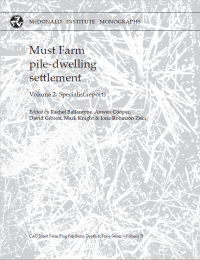
The Late Bronze Age pile-dwelling settlement at Must Farm is one of the most important and best-preserved prehistoric sites to have been systematically excavated in Europe. The settlement comprised a curving palisade enclosing five stilt-raised houses erected above a freshwater river channel at the edge of one most Britain’s most intensively studied and internationally renowned Bronze Age landscapes: the Flag Fen Basin.
Built in the mid-9th century BC, the pile-dwelling was engulfed by a catastrophic fire less than a year after construction, sending the buildings and their artefact-rich contents into the sluggish waters below. A combination of fire, water and rapid burial ensured extraordinary levels of preservation, whilst the manner of collapse and brevity of settlement gave the structural remains, and their vibrant material assemblages, a pristine quality. Each household had its own inventory comprising combinations of delicate textiles, wooden containers, hafts and wheels, complete pottery sets, bronze toolkits and the scattered remnants of necklaces of glass beads. Food remains included butchered wild and domestic animal bones, charred plants and seeds, and even the burnt residues of individual meals.
This comprehensive and methodologically innovative investigation, incorporating an array of scientific studies and collaborations amongst leading specialists, provides unprecedented insights into the nature of daily life and domestic practice in Bronze Age society. These challenge many expectations about the material worlds that people inhabited, shedding new light on aspects of architecture, material abundance, foodways, woodland management, landscape change and wetland living. The collective results are truly ground-breaking for Wetland Archaeology and wider Bronze Age studies. Volume 1 provides a thematic interpretive synthesis of the site, with a focus on landscape, architecture and occupation, whilst Volume 2 offers in-depth studies of the river setting, construction, dating, material culture and biological remains.
2023
Interamna Lirenas A Roman town in Central Italy revealed
edited by: Alessandro Launaro & Martin Millett
Hardback | £52.00 / US $65.00 | ISBN 978-1-913344-10-8 | xi + 157 pp. | 60 figs | 2 tables | 2023 | Buy now
eBook | ISBN 978-1-913344-11-5 | xi + 157 pp. | 60 figs | 2 tables | 2023 | Download now for free
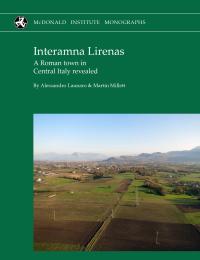
The Roman town of Interamna Lirenas (Southern Lazio, Central Italy) was established as a colony in 312 bc and was occupied until the 6th century ad. Despite its long life, it has since almost disappeared from view: until recently, the site only featured a series of crop fields, its visible archaeology amounting to little more than a dense ploughsoil assemblage, with very few standing remains. However, since 2010 an integrated archaeological project by the Faculty of Classics of the University of Cambridge, in collaboration with various other institutions, has explored both the town and its surrounding countryside through geophysical prospection, field survey and excavation. The research presented in this volume covers survey work over the urban area. It provides an account and discussion of the results of our application of non-destructive archaeological methods (geophysical prospection and systematic surface collections) to the study of the urban site. It includes a review of what was known of the town prior to our involvement, and also a discussion of the development, potential and limitations of the kind of high-resolution, extensive ground-penetrating radar survey which was carried out. This study places special emphasis on the earliest colonial phase as well as later transformations, and explores how the inhabitants of Interamna Lirenas responded to the challenges and opportunities presented by a growing Roman world, thus identifying the conditions that contributed to the town as a successful urban centre. This volume thus contributes substantial new evidence to broader historical debates about the political, social, economic and cultural development of Roman urbanism, in Italy and beyond.
Alessandro Launaro FSA is Associate Professor in Classics (Classical Art & Archaeology) at the Faculty of Classics of the University of Cambridge and a Fellow of Gonville & Caius College, Cambridge.
Martin Millett FBA FSA MAE is Emeritus Laurence Professor of Classical Archaeology at the Faculty of Classics of the University of Cambridge and a Fellow of Fitzwilliam College, Cambridge.
Ancient Egyptian gold: Archaeology and science in jewellery (3500-1000 BC)
edited by: Maria Filomena Guerra, Marcos Martinón-Torres & Stephen Quirke
Hardback | £65.00 / US $82.00 | ISBN 978-1-913344-12-2 | xxv + 495 pp. | 415 figs | 88 tables | 2023 | Buy now
eBook | ISBN 978-1-913344-13-9 | xxv + 495 pp. | 415 figs | 88 tables | 2023 | Download now for free
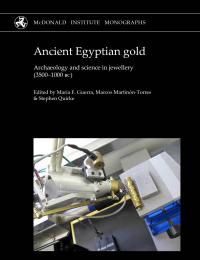
This book aims to provide a new level of synthesis in the study of gold jewellery made in Egypt between 3500 bc and 1000 bc, integrating the distinct approaches of archaeology, materials science and Egyptology. Following accessible introductions to the art and use of gold in Ancient Egypt, and to current advances in technical analyses, the volume presents detailed results on the manufacturing technology and elemental composition of some 136 objects in the collections of six European museums, with discussion of the findings in historical and cultural contexts. The questions generated by the jewellery buried with a woman and a child at Qurna (Thebes) led to investigation of assemblages and individual artefacts from later and earlier periods in varied social contexts, from the rural environment of Qau and Badari, to sites connected with urban or royal centres, such as Riqqa, Haraga and Lahun. A final discussion of the Qurna group provides an agenda for future research.
Maria F. Guerra is Director of research in Chemistry at the National Center for Scientific Research (UMR 8233 MONARIS, Sorbonne University). Her interests are in the analytical study of goldwork.
Marcos Martinón-Torres is Pitt-Rivers Professor of Archaeological Science at the University of Cambridge, and editor of the Journal of Archaeological Science. He has a particular interest in past technologies.
Stephen Quirke is Edwards Professor of Egyptian Archaeology and Philology at the UCL Institute of Archaeology. His interests include Middle Kingdom social history, as well as the history of archaeology and collections.
2022
Inspired geoarchaeologies: past landscapes and social change Essays in honour of Professor Charles A. I. French
edited by Federica Sulas, Helen Lewis & Manuel Arroyo-Kalin
eBook | ISBN 978-1-913344-09-2 | xvii + 283 pp. | 116 figs | 22 tables | 2022 | Download now for free
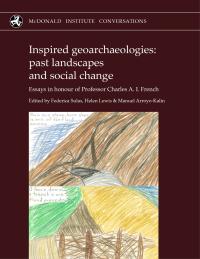
Geoarchaeological research captures dimensions of the past at an unprecedented level of detail and multiple spatial and temporal scales. The record of the past held by soils and sediments is an archive for past environments, climate change, resource use, settlement lifeways, and societal development and resilience over time. When the McDonald Institute was established at Cambridge, geoarchaeology was one of the priority fields for a new research and teaching environment. An opportunity to develop the legacy of Charles McBurney was bestowed upon Charles French, whose ‘geoarchaeology in action’ approach has had an enormous impact in advancing knowledge, principles and practices across academic, teaching and professional sectors. Many journeys that began at Cambridge have since proliferated into dozens of inspired geoarchaeologies worldwide. This volume presents research and reflection from across the globe by colleagues in tribute to Charly, under whose leadership the Charles McBurney Laboratory became a beacon of geoarchaeology.
Federica Sulas is a senior research associate at the McDonald Institute for Archaeological Research, University of Cambridge. Her background is in oriental studies and African archaeology (BA Hons, Naples) and geoarchaeology (MPhil & PhD, University of Cambridge). Her main research interests are in landscape historical ecologies and water–food security.
Helen Lewis is an associate professor at University College Dublin School of Archaeology. Her background is in archaeology and anthropology (BA, University of Toronto), environmental archaeology (MSc, University of Sheffield) and archaeological soil micromorphology (PhD, University of Cambridge). She mostly works today on cave sites in Southeast Asia, but she still loves northwest European Neolithic and Bronze Age monuments and landscapes, and ancient agricultural soils.
Manuel Arroyo-Kalin is Associate Professor of Geoarchaeology at the Institute of Archaeology, UCL. He is interested in the Anthropocene, human niche construction and historical ecology, and uses earth science methods, including soil micromorphological analysis, to study past anthropic landscape modification and anthropogenic soil formation. His main research focus is the pre-Colonial human landscape history of tropical lowland South America, particularly the Amazon basin, where he is engaged in the long-term comparative study of Amazonian dark earths.
Temple people: Bioarchaeology, resilience and culture in prehistoric Malta
edited by Simon Stoddart, Ronika K. Power, Jess E. Thompson, Bernardette Mercieca-Spiteri, Rowan McLaughlin, Eóin W. Parkinson, Anthony Pace & Caroline Malone
Hardback | £65.00 / US $86.00 | ISBN 978-1-913344-07-8 | xxvii + 344 pp. | 331 figs | 58 tables | 2022 | Buy now
eBook | ISBN 978-1-913344-08-5 | xxvii + 344 pp. | 331 figs | 58 tables | 2022 | Download now for free
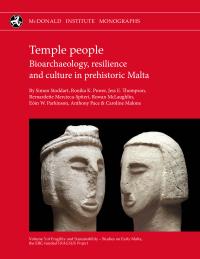
The ERC-funded FRAGSUS Project (Fragility and sustainability in small island environments: adaptation, culture change and collapse in prehistory, 2013–18) led by Caroline Malone has focused on the unique Temple Culture of Neolithic Malta and its antecedents. This third volume builds on the achievements of Mortuary customs in prehistoric Malta, published by the McDonald Institute in 2009. It seeks to answer many questions posed, but left unanswered, of the more than 200,000 fragments of mainly commingled human remains from the Xagħra Brochtorff Circle on Gozo. The focus is on the interpretation of a substantial, representative subsample of the assemblage, exploring dentition, disease, diet and lifestyle, together with detailed understanding of chronology and the affinity of the ancient population associated with the ‘Temple Culture’ of prehistoric Malta. The first studies of genetic profiling of this population, as well as the results of intra-site GIS and visualization, taphonomy, health and mobility, offer important insights into this complex mortuary site and its ritual.
Remarkable evidence on the bioanthropology of care practised by these populations, together with a relatively low level of interpersonal violence, and examples of longevity, reveal new aspects about the Neolithic Maltese. Detailed case studies employing computerized tomography describe disease such as =scurvy and explore dietary issues, whilst physical activity and body size have been assessed through biomechanical analysis, supported by taphonomic study, isotopic analyses, a review of mortuary practices during prehistory and a robust new chronology. The results form a rich contextualized body of material that advances understanding of cultural change within the context of small island insularity, and provides biological comparisons for the graphic figurative art of early Malta. These data and the original assemblage are conserved in the National Museum of Archaeology in Valletta as a resource for future study.
Simon Stoddart is Professor of Prehistory in the Department of Archaeology, University of Cambridge.
Ronika K. Power is Professor of Bioarchaeology in the Department of History and Archaeology at Macquarie University, and the Director of the Centre for Ancient Cultural Heritage and Environment (CACHE).
Jess E. Thompson is a research associate on the ‘ANCESTORS’ project at the McDonald Institute, Cambride.
Bernardette Mercieca-Spiteri is the osteological officer of the Superintendence of Cultural Heritage of Malta.
Rowan McLaughlin is a Pathway Fellow at the Hamilton Institute, National University of Ireland, Maynooth, where he is principal investigator of the IRC-funded project ‘A deep history of Ireland for the Information Age’.
Eóin W. Parkinson is a Leverhulme Research Fellow at the Department of Classics and Archaeology of the University of Malta.
Anthony Pace was Superintendent of Cultural Heritage on Malta during the course of the FRAGSUS Project.
Caroline Malone is Professor in the School of Natural and Built Environment, Queen’s University Belfast.
2021
Gardening time: Monuments and landscape from Sardinia, Scotland and Central Europe in the very long Iron Age
edited by Simon Stoddart, Ethan D. Aines & Caroline Malone
eBook | ISBN 978-1-913344-04-7 | xxii + 242 pp. | 96 figs | 5 tables | 2021 | Download now for free
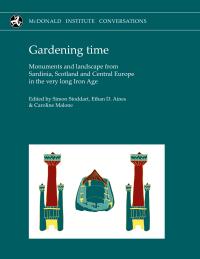
Gardening may seem worlds away from Nuraghi and brochs, but tending a garden is a long process involving patience, accretion and memory. Scholars argue that memories are also cultured, developed and regained. The monuments in Scotland and Sardinia are testament to the importance of memory and its role in maintaining social relations. This collection of twenty-one papers addresses the theme of memory anchored to the enduring presence of monuments, mainly from Scotland and Sardinia, but also from Central Europe and the Balkans.
Simon Stoddart is a Professor in the Department of Archaeology, University of Cambridge.
Ethan D. Aines is a Policy Assistant at Cambridge Zero, Centre for Science and Policy at the University of Cambridge.
Caroline Malone is Professor of Prehistory at Queen’s University, Belfast
Fierce lions, angry mice and fat-tailed sheep: Animal encounters in the ancient Near East
edited by Laerke Recht and Christina Tsouparopoulou
eBook | ISBN 978-1-913344-05-4 | xiii + 289 pp. | 99 figs | 20 tables | 2021 | Download now for free
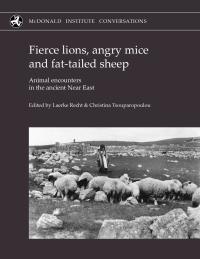
Animals have always been an integral part of human existence. In the ancient Near East, this is evident in the record of excavated assemblages of faunal remains, iconography and – for the later historical periods – texts. Animals have predominantly been examined as part of consumption and economy, and while these are important aspects of society in the ancient Near East, the relationships between humans and animals were extremely varied and complex.
Domesticated animals had great impact on social, political and economic structures – for example cattle in agriculture and diet, or donkeys and horses in transport, trade and war. Fantastic mythological beasts such as lion-headed eagles or Anzu-birds in Mesopotamia or Egyptian deities such as the falcon-headed god Horus were part of religious beliefs and myths, while exotic creatures such as lions were part of elite symbolling from the fourth millennium bc onward. In some cases, animals also intruded on human lives in unwanted ways by scavenging or entering the household; this especially applies to small or wild animals. But animals were also attributed agency with the ability to solve problems; the distinction between humans and other animals often blurs in ritual, personal and place names, fables and royal ideology. They were helpers, pets and companions in life and death, peace and war. An association with cult and mortuary practices involves sacrifice and feasting, while some animals held special symbolic significance.
This volume is a tribute to the animals of the ancient Near East (including Mesopotamia, Anatolia, the Levant and Egypt), from the fourth through first millennia bc, and their complex relationship with the environment and other human and nonhuman animals. Offering faunal, textual and iconographic studies, the contributions present a fascinating array of the many ways in which animals influence human life and death, and explore new perspectives in the exciting field of human-animal studies as applied to this part of the world.
Laerke Recht is Professor of Early Eastern Mediterranean Archaeology at the University of Graz, Austria, and a former Marie Skłodowska-Curie Fellow at the McDonald Institute of Archaeological Research, University of Cambridge. She is particularly interested in and has published on human–animal relations in the ancient Near East, Cyprus and Aegean.
Christina Tsouparopoulou is Assistant Professor in Near Eastern Archaeology at the Polish Academy of Sciences, Warsaw, Poland, Senior Research Associate and Marie Skłodowska-Curie Fellow at the McDonald Institute of Archaeological Research and Fellow of Wolfson College, Cambridge. She specializes in the material and textual culture of the Near East and Eastern Mediterranean in the third and second millennia bc.
Making cities: Economies of production and urbanization in Mediterranean Europe, 1000 - 500 BC
edited by Margarita Gleba, Beatriz Marín-Aguilera and Bela Dimova
eBook | ISBN 978-1-913344-06-1 | xvii + 454 pp. | 231 figs | 22 tables | 2021 | Download now for free
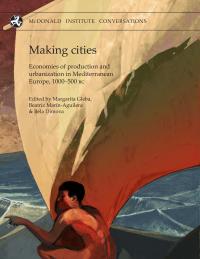
Large and complex settlements appeared across the north Mediterranean during the period 1000–500 bc, from the Aegean basin to Iberia, as well as north of the Alps. The region also became considerably more interconnected. Urban life and networks fostered new consumption practices, requiring different economic and social structures to sustain them. This book considers the emergence of cities in Mediterranean Europe, with a focus on the economy. What was distinctive about urban lifeways across the Mediterranean? How did different economic activities interact, and how did they transform power hierarchies? How was urbanism sustained by economic structures, social relations and mobility? The authors bring to the debate recently excavated sites and regions that may be unfamiliar to wider (especially Anglophone) scholarship, alongside fresh reappraisals of well-known cities. The variety of urban life, economy and local dynamics prompts us to reconsider ancient urbanism through a comparative perspective.
Margarita Gleba is a Professor at the University of Padua and Honorary Senior Lecturer at University College London.
Beatriz Marín-Aguilera is a Renfrew Fellow at the McDonald Institute for Archaeological Research, University of Cambridge.
Bela Dimova is a A. G. Leventis Fellow in Hellenic Studies at the British School at Athens.


